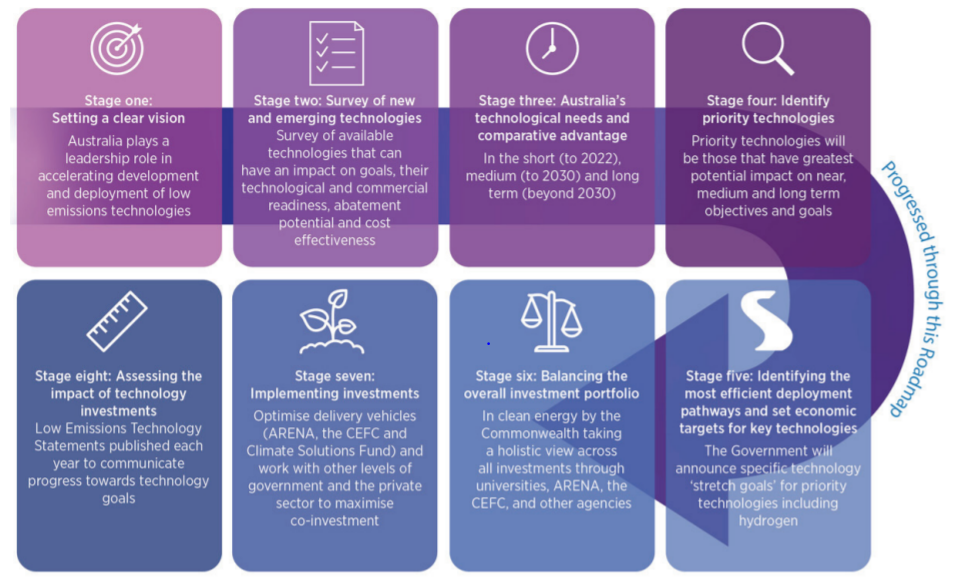
Creating Australia's low-emissions future: Government seeks comment on Technology Investment Roadmap Discussion Paper

The Commonwealth Government has released its Technology Investment Roadmap Discussion Paper as a first step to establishing a long-term plan for low-emissions technology investment in Australia.
The Discussion Paper sets out the Government's position on the analyses of 140 low-emissions technologies, both emerging and established, and proposes governance structures for identifying priority technologies for investment.
The Roadmap
The proposed Roadmap sets a path for settling on goals and priorities for low emissions investment later this year. Through a Government appointed Ministerial Reference Panel chaired by Australia's Chief Scientist Dr Alan Finkel AO, it plans to publish an annual Low Emissions Technology Statement. Each statement will communicate Australia's progress towards a (yet to be defined) technology goal.
A snapshot of the proposed Roadmap from the Discussion Paper is below.

Main energy focuses of the Technology Investment Roadmap Discussion Paper
Renewables
The Discussion Paper recognises the decarbonisation of the electricity grid and "negative emission technologies" as essential for lowering Australia's emissions, with renewable energy front and centre, backed by gas and hydrogen to firm (or secure) the grid.
Wind and solar are currently the cheapest methods of energy generation and therefore recognised as "off the ground' and no longer in need of significant Government support.
Natural gas
Natural gas generation is seen by the Government as a big part of the plan to lower-emissions and provide affordable firming. The production of natural gas is already significantly established in Australia so is said to provide "quick wins".
The Government's focus on Australia's deep natural gas reserves serves the multiple purposes of producing grid reliability, emissions reductions and also export dollars.
However, the role gas should play in Australia's transition to a net zero emissions economy continues to be debated. Gas might have a 50% lower emissions profile than burning coal, making it an attractive transition tool, but it is also a combustible energy source which itself will eventually need to be phased out.
Clean hydrogen
The Discussion Paper focusses on the potential for Australia to become a market leader in clean hydrogen, including in the overseas export market (to countries like Japan).
Hydrogen comes in three colours: grey (produced from fossil fuels), blue hydrogen (produced by non-renewable sources such as carbon capture storage (CCS) or nuclear) and green hydrogen (generated by renewable energy sources). The Discussion Paper uses the term "clean hydrogen" to refer to both blue and green hydrogen.
Clean hydrogen is currently expensive in comparison to fossil fuels and grey hydrogen, but with targeted investment, forecasts predict it could be made economically competitive relatively quickly. One concrete goal of the Roadmap is achieving production of clean hydrogen for under $2 per kilogram.
Nuclear
While nuclear technology is only mentioned in passing, the Roadmap states that the future possibility of Small Modular Reactors (SMRs), a Gen III+ and Gen IV nuclear technology should be considered, pending observation of their progress in the US. Legislative intervention would be required to override the current prohibition on nuclear energy in Australia.
The (mixed) response so far
The response so far from stakeholders to the suggested Roadmap has been varied and broad, reflective of the range of technologies considered and its energy neutral approach.
The oil and gas sector welcomes the major part to be played by natural gas in Australia's energy future, while the Clean Energy Council sees the focus on renewables as a first step towards establishing objective energy goals.
There is significant concern from climate organisations that the heavy reliance on CCS technology (including in the production of blue hydrogen) is both economically unsound and will act to extend the presence of the fossil fuel industry in Australia's future energy mix.
Independent Zali Steggall MP has raised concerns about the accountability and transparency of the governance structures embedded in the road map, calling for greater independence. She plans to progress her Climate Change (National Framework for Mitigation) Bill 2020 to set a Commonwealth target of net zero emissions by 2050 and sees a place for a form of the Government's Roadmap sitting beneath her proposed legislation.
The lack of reference to coal in the Roadmap has sparked division amongst the LNP, with Deputy Prime Minister Michael McCormack, former leader Barnaby Joyce, and former Resources Minister Matt Canavan arguing that the exclusion of coal from the Roadmap should be remedied in future drafts.
Where to from here?
Although the Roadmap makes no reference to international targets, Australia's 2030 emissions reduction target is looming, together with the emerging impacts of a warmer world, making fast reductions a priority.
The Government is looking for stakeholder input on establishing economic stretch goals, as well as opinions on hydrogen, CCS, biological sequestration, firmed renewables and long duration energy storage. It plans to release its long-term emissions reductions strategy, and the first Low Emissions Technology Statement based on the consultation by the end of September, and before the COP26 climate talks (on a date to be confirmed).
If you would like to understand more about the impact on your business, or help in crafting your response, please contact us.
